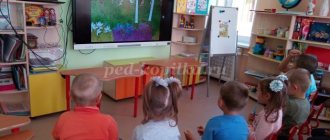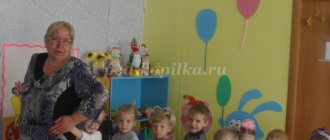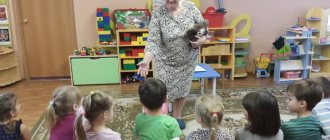Summary of a lesson on ecology in kindergarten in the senior group “What changes in the forest in autumn”
Abstract of educational activities on cognitive development (ecology) in the senior group “What changes in the forest in the fall”
Author of the work: Shakleina Irina Yuryevna, teacher at MADOU Central Regional Development District No. 110 Kaliningrad region, Kaliningrad city. This material will be useful for preschool teachers in working on cognitive development with older children and for parents. Objectives: Educational:
- generalize and systematize children’s ideas about autumn changes in nature and in the life of animals in the forest;
- learn to see relationships and interdependencies in nature, independently establish the simplest cause-and-effect relationships; Developmental:
- develop attention, memory, logical thinking;
- expand and activate children’s speech reserves based on deepening their understanding of the environment; — enrich children’s vocabulary with words and concepts (silent hunting, straight front or single file, murmuration). Educational:
to instill in children a caring attitude towards the forest and its inhabitants (animals, plants, mushrooms).
Health-saving:
creating emotional comfort and psychological safety.
Materials and equipment: balancing massage hemisphere – 3-4 pcs. (bumps), board or ribbed board (“log”), presentation “Autumn Forest”, pictures of mushrooms, pictures “Wintering birds and city birds”, in a beautiful envelope coloring theme "Autumn".
Progress of the lesson
I.
Children enter the group and greet the guests. Morning greeting Hello, golden sun! Hello, blue sky! Hello, light breeze! Hello, you are my friend! Hello, you are dear guests! Educator: - Guys, what mood are you in today? (good, cheerful)
.
Great, I wish your mood to always be like this. Today I invite you to take a walk-excursion into the forest. What is FOREST? (This is a place where many trees, shrubs, berries, mushrooms grow, animals, birds, insects live)
What
rules of conduct in the forest do you know? - you can’t make noise or run in the forest; - we need to take care of anthills, ants are the orderlies of the forest; - do not come close to nests or destroy bird nests; - you cannot catch animals and birds and take them home; - you cannot light a fire; many plants and insects die from the fire. Educator: - Well done! You know the rules of behavior in the forest, which means you can go visit. I will be your tour guide. Motor exercise “Walk in the forest” Let’s go for a walk in the forest. Let's march merrily (children march)
.
Let's walk along the path, one after another, in single file (they walk like a “snake” between the hummocks)
.
We raise our legs higher. We don’t step on bumps (high step, step over hemispheres - bumps)
.
We put our hands behind our backs and walk along the log! (Children walk along the board)
And again along the path We walk
(march)
.
(1 slide)
Educator: - Here we are. Look how beautiful it is. What forest are we in? (in autumn)
.
How did you know that this was an autumn forest? (all the trees and grass turned yellow)
The forest, like a painted tower, purple, gold, crimson, stands like a cheerful, motley wall above a bright clearing.
- Name what other signs of autumn there are (it’s cold, foggy, it’s raining, leaves are falling, the grass is turning yellow, insects are disappearing, animals are preparing for winter, birds are flying away...)
.
Why do trees shed their leaves in the fall? (if the leaves do not fall, tree branches may break from the weight of the snow)
.
- Yes, this is how trees prepare for winter by shedding their leaves, they protect themselves. II. Educator: - How nice it is in the forest! How clean the air is in the forest. Let us breathe this air (elements of breathing exercises)
.
- Why do people go to the forest? (breathe fresh air, pick mushrooms, berries, pine cones, enjoy the beauty, watch the animals)
.
- Let’s pick mushrooms too, only those that are called “Edible” (children choose one picture with edible mushrooms)
.
- Why didn’t you take these mushrooms? (they are poisonous)
. Please tell me, is it necessary to crush poisonous mushrooms with your feet?
Finger gymnastics We collected edible mushrooms for a long time, And then we told our friends: (children, naming mushrooms, bend their fingers in turn) A
boletus grew in the forest, And under the oak tree, Honey mushrooms are sitting on a stump - Very friendly guys.
The boletus grew under the young aspen, the large boletus grew under the white birch. We won't take fly agaric. It grows for the animals! If you go into the forest with us, (“walk” with your fingers on your palm),
you will find a lot of mushrooms.
(raise their hands up with unclenched fingers) Educator: - picking mushrooms in the forest is called quiet hunting... - Tell me, you don’t know why it became so quiet in the forest? (migratory birds have flown away)
.
Why are they flying away? (Migratory birds feed on insects, and in the fall the insects disappear) Educator: - birds fly away first, insectivores - swallows, swifts, wagtails, larks; then the birds fly away and find food on the ground, because the worms disappear, the frogs hide - these are starlings, rooks, cranes, storks. The last to fly away are waterfowl when the water in reservoirs begins to become covered with a thin crust of ice - geese, ducks, swans. What birds stay with us for the winter? (wintering)
.
Do you know which birds stay in the forest for the winter? I propose the game “Find the wintering birds of the forest” (pictures with types of urban and forest birds are mixed, they need to be divided into two groups)
.
— How can people help birds survive the winter?
(hang up feeders, feed birds with grains and seeds)
.
Yes, we can help those birds that live next to humans, but those that live in the forest have to look for food themselves. And a bird like the crossbill also hatches chicks in winter. (3rd slide) Children sit on chairs.
The magic screen will show us how birds fly away to warmer climes
(straight ahead or in single file, bird wedge)
(4th slide)
crowded flock
(the concept of “Murmuration”)
)
- We stayed a little late. Let's warm up... Physical exercise The sun is shining from the sky, (hands up)
The forest woke up early.
In order for everyone to have time for everything, (stretch)
You need to wake up with the sun.
Everything is in order with the squirrels. (one hand up, the other down)
In the morning everyone is ready to exercise.
Training (jumping)
to jump through trees deftly.
Long ears flash - (“ears”)
Hares are jumping on the edge
(jumping on two legs)
It’s time for the hares to have breakfast -
(sit down, “eating grass”)
The grass is delicious in the morning.
A bear cub clubfoot (“clubfooted”)
catches fish in the river with its paw.
(catches fish with his paw)
But the fisherman’s catch is only seaweed for now.
The hedgehog is in a hurry, puffing - (mincing step in place)
The appetite has worked up.
(stroking the tummy)
For breakfast I found a fungus,
(bend over for the fungus)
, I attached it to my side.
(attach it on its side)
For animals, the forest is home.
(hands with a house)
If we go to visit them, we must know perfectly well how to behave decently: Do not break tree branches
(wag your finger)
And do not tear rare plants, Do not make noise, do not burn fires, Protect the forest from garbage!
(5th grade)
Now I suggest you observe what the animals are doing in the forest in the fall.
Watch the video “Life of wild animals in autumn”
.
III. (6th slide)
Educator: - our walk through the autumn forest ends. Listen to the woodpecker say goodbye to you: “Goodbye!” I would like to ask you what you liked and what you learned? What do you like most about autumn? Autumn gave you a gift - coloring books. Thank you for being attentive, careful and careful with nature in the forest. It's time for us to return to the garden: We are going to kindergarten, (children marching)
.
Let's walk along the path, one after another, in single file (they walk like a “snake” between the hummocks)
.
We raise our legs higher. We don’t step on bumps (high step, step over leaves)
.
We put our hands behind our backs and walk along the log! (Children walk along the board)
And again along the path We walk
(march)
.
We recommend watching:
Speech therapy lesson in the senior group on the topic: Autumn Lesson summary - excursions in the senior group of kindergarten. Journey to the autumn forest Educational activities in the senior group on the lexical topic “Autumn. Trees" Summary of a modeling lesson in the senior group of a preschool educational institution on the topic: Autumn
Similar articles:
Summary of a lesson in the senior group on an autumn theme based on the fairy tale “Apple” by V. Suteev
Summary of a lesson in the senior group on the topic “Harvest, vegetables, fruits”
MAGAZINE Preschooler.RF
Abstract of the educational activity “Passing the ecological trail in autumn”AGE GROUP: Middle group.
Goal: To summarize children’s knowledge on the topic “Autumn” .
Objectives: Creating conditions for expanding children’s ideas about autumn changes in nature. Show the objects of the ecological trail in the autumn. Create conditions for the formation of a caring attitude towards the environment. Give basic ideas about the relationship between man and nature.
Materials: Objects of the ecological trail: birch, rowan, flowerbed, birdhouse on a tree, stump.
Progress of activities:
Educator. Children, today we will walk along an ecological trail.
The children go outside and are greeted by Grandfather Naturalist.
Grandfather Naturalist. Today, guys, I will reveal to you some secrets of nature.
Educator. Grandfather, our children are very inquisitive, they will certainly be interested! Really, guys?
Grandfather Naturalist. Guys, do you know what time of year it is now? (children's answers).
Educator. Reads M. Avdeeva’s poem “Colorful Park...” .
Invites children to run through the leaves and listen to them rustle.
Educator. One, two, three - run to the birch! Children run to the birch tree.
Grandfather Naturalist. Children, how did you know it was a birch tree? (Children's answers). Find and show me a birch leaf. Look carefully at the birch leaves. What color are they?
Educator. And here's another tree. (Points to the rowan tree). Who knows what it's called? (Children's answers.) Correct. How did you guess that it was a mountain ash? (Children's answers.)
The teacher invites the children to carefully examine the rowan leaves.
Draws their attention to the fact that they are different from the leaves of other trees: the leaf seems to consist of several small leaves.
Grandfather Naturalist. Next, the ecological path leads us to a flower bed. Do you know the names of the plants that grow in the flowerbed? (Children's answers.) These are asters. Asters come in different colors. What color are the asters in this flowerbed? (Children's answers.) Let's look at a flower that has ripened seeds in the middle. By planting these seeds, new plants can be grown.
Educator. Children, why do you think people plant flowers in flower beds? (Children's answers.) Of course, so that it is beautiful. Look how beautiful it is when different flowers bloom in the flower beds.
Grandfather Naturalist leads further along the ecological path.
Grandfather Naturalist. Do you know who lives in this house? (Points to the birdhouse.)
The teacher summarizes the children’s answers: “Starlings live in this house, and the house is called a birdhouse . Where are the birds? (Children's answers.)
Grandfather Naturalist. Our next stop will be near a tree stump. Who knows what a stump is? (Children's answers.) Look, once there was a tree here, but it grew old and dried up, then it was cut down. A stump remained in place of the tree. Do you think anyone lives on a stump? (Children's answers.) Life also goes on in this stump. Small bugs and insects hide in the stump. They climb into a stump and stay there all cold winter - this is their home.
Educator. These are the stops we made today on our ecological path. Guys, what did you learn new and interesting? (Children's answers).
Grandfather Naturalist invites children to play.
“Find the same piece of paper as I show you” is played . The game is repeated with different leaves.
Grandfather Naturalist. Guys, I want to give you some leaves to color as a souvenir of our meeting.
Grandfather Naturalist distributes paper silhouettes of leaves to the children and says goodbye to them.
The children return to the group.
| Next > |


